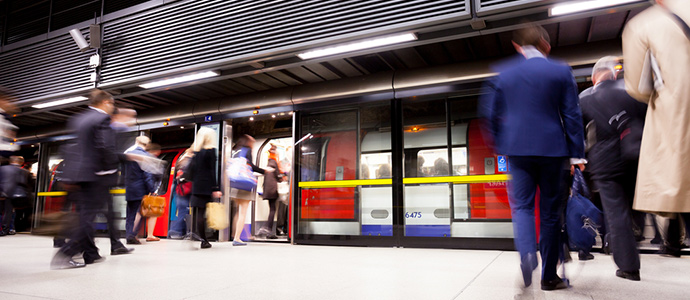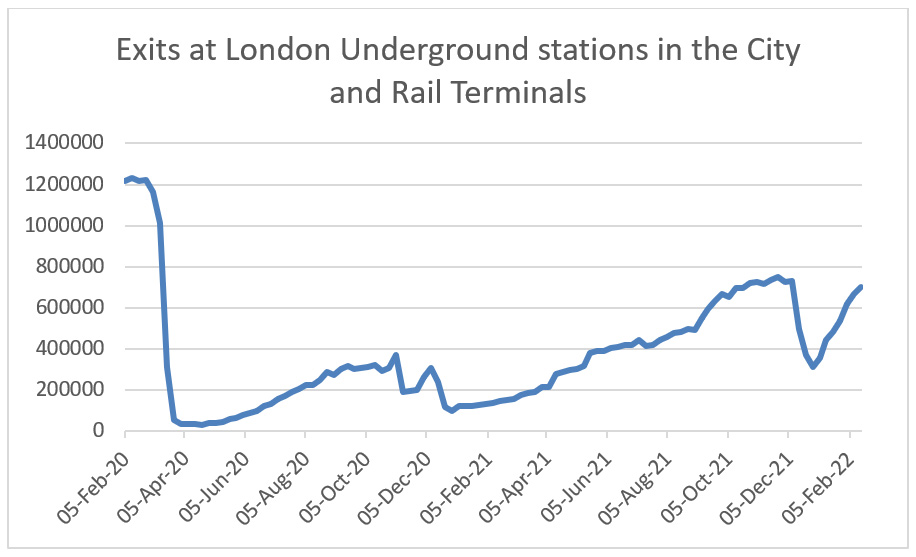I don’t like Mondays

Data from London Underground stations points to a V-shaped recovery for commuting and reveals which days we prefer to work from home.
A huge debate in property since the pandemic began has surrounded the future balance between time spent in the office vs homeworking. An informative indicator Avison Young has been tracking is exits at London Underground stations in the City of London (the UK capital’s largest financial district) and at the main London railway terminals. We view this as a good barometer for office workers commuting on weekdays in London.

Source: Transport for London
Back to work
The good news for landlords is that when office workers are not prevented by government home working orders they drift back to work in progressively higher numbers. In early February 2021, the London Underground stations in our sample were averaging 142,000 exits per day, which by November 2021 had reached 731,000 a day. The upwards trend corresponded with the gradual easing of Covid rules and demonstrates that both employers and workers view some degree of office attendance as essential.
However, during November 2021, the stations were only seeing around 60% of the passenger numbers they typically saw in February 2020, when Covid had yet to reach the UK in significant numbers. During 2021, many companies made announcements about their preferred balance between office and home working, with most suggesting two to three days a week in the office would be acceptable. This sits well with the London Underground data pointing to stations operating at around 60% of pre-Covid levels.
During December, another work from home order sent the figures plunging again. However, an encouraging development has been the speed with which commuting rebounded when the work from home order was lifted. Stations were operating at 26% of pre-pandemic levels in late December 2021; but had recovered to nearly 58% by mid-February 2022. It took 24 weeks for passenger numbers to rise from 26% to 58% during 2021. In 2022, it took just seven weeks. People want to go back to the office… but perhaps not every day.
That Monday feeling
When we look at the data for the sample stations for days of the week, we see a significant shift in activity for Mondays and Fridays. Even before Covid arrived, typically station activity varied from day to day, usually peaking on a Thursday. Monday was generally the quietest weekday – with 10.3% less activity on average than the Thursday peak. Passenger numbers tended to be only marginally lower on Friday (down 2.3%) compared to Thursday.
However, more recent data shows much lower passenger numbers for Mondays and Fridays, which are now seeing a more significant drop compared to Thursdays. We looked at the period from late November 2021 to mid-February 2022, excluding the weeks in December and early January when there was a work from home order in England. The figures showed Thursday still as the peak day for travel, but with Monday now 23.5% lower than Thursday, and Friday 7.0% less. Google data also shows a pattern of lower workplace attendance and transit station use on Mondays, and a gentler fall on Fridays.
New Normal
Few people believe that the world will ever return to a situation of people typically working five days a week in the office. Indeed, the London Underground data suggests that even pre-pandemic there was already less commuting occurring on Mondays. Staff perhaps view working from home on Monday as a good way to ease the transition from weekend relaxation to the working week. For employers, allowing home working on Monday offers staff a better work/life balance and guarantees time for more solitary tasks, like report writing.
Recent data showing a 7% fall in commuters on a Friday compared to Thursday , beckons the question: could employers succeed in reversing this decline? After all, pre-pandemic Friday was only seeing slightly lower numbers than Thursday.
In the late 1990s / early 2000s there was a move in many firms towards making Friday a more relaxed day, with casual dress and an early finish accompanied by food and drink in the office. This left a lasting mark on the workplace, with many firms subsequently making casual dress the norm and introducing games rooms and café areas into their offices. There have been press reports in recent months of firms using social events and free food to entice staff back to the office. Also, the ending of all restrictions in England and lower Covid infection numbers raises the possibility of the Friday evening trip to the pub with colleagues making a comeback.
The big question now is: how will the recent lifting of restrictions impact office attendance, particularly in the light of falling infections? If station use was at 58% prior to the end of restrictions, it seems logical that the numbers will rise as concerns over the risk of infection during commuting recede. Consequently, the new normal may be higher than the two to three days a week in the office figure that many employers were suggesting last year. It should be remembered that the reasons for office attendance are complex and vary from person to person. They can stretch from there being no ideal place in an individual’s home to work, to someone wanting to be in the city centre when they finish work because they are meeting friends.
Consequently, we probably need a lot more data to reach firm conclusions and require a time series that covers several months of the new ‘living with Covid’ era we have now entered. This we suspect will reveal a complex relationship between workers and the office, that ebbs and flows from day-to-day, and according to what tasks and meetings are in the diary for a given week. Moreover, the dynamics of individuals’ personal lives, not just work patterns, are likely to be a major factor shaping where and when we go to the office.
This article was first published in Property Chronicle, April 2022.

